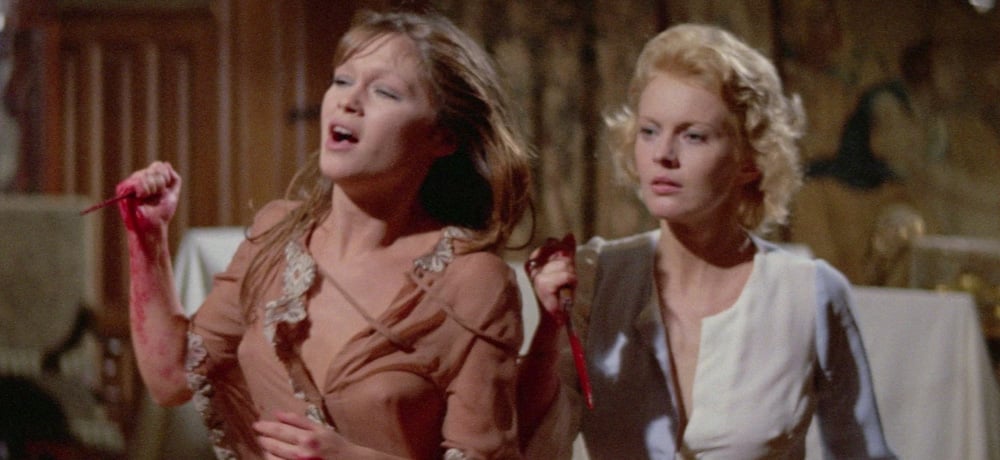


Let’s offer up a slow clap for the slow-moving films; the ones that want you to lean in and invest a little extra time (or a lot) to get to know the characters better, or weave words and deeds into the fabric of the story to enrich the experience. Sometimes it’s just shitty editing. So it goes; but The Corruption of Chris Miller (1973), a Spanish psychothriller sucker-punched by moments of grisly grandeur, slowly turns to unveil a sordid tale of deception, trust, carnal curiosity, and the occasional striking murder. It moves with deliberation and respect for the tale.
Released at home in May and not hitting Stateside until September of ‘75, The Corruption of Chris Miller (aka La corrupción de Chris Miller, Behind the Shutters, Patty Cake, Patty Cake, Killer Man, Sisters of Corruption) received solid reviews for the most part, with critics praising director J.A. Bardem’s (Death of a Cyclist) deft touch with the quiet moments just as much as the explosive violence. Marketed to compete with the popular Italian giallo of the day, Chris Miller takes a different route: madness, gaslighting, and greed featured in a bomb-laden waltz, with all eyes on the three lead dancers.
We open on a rainy Spanish countryside as a retired burlesque performer (Perla Cristal - The Fury of the Wolfman) tries to kick out her transient boyfriend of two weeks; dressed in her Charlie Chaplin mask and top hat, he bids her a bloody adieu before running off through the woods. Cut to the nearby manor of Ruth Miller (Jean Seberg - Breathless) and her stepdaughter Chris (Marisol - The Days of the Past) ; Chris is haunted by two recent events - her father left them the year before, and then she was raped in a locker room shower - and leans on Ruth to care for her, however reluctantly.
Enter one Barney Webster (Barry Stokes - Prey), a British traveler hiking his way across the Spanish countryside; his loose tongue and devilish front ingratiates him to Ruth, and he finds himself the new handyman at the Miller residence. Chris isn’t pleased, as she doesn’t trust Barney; nor should she as he snoops around the house looking for treasures. Barney’s appearance coincides with a rash of shocking murders in the area (a continuation of our opening salvo), including an entire family in a farmhouse; despite seducing both, Chris and Ruth become convinced that Barney has more on his mind than lust…
The Corruption of Chris Miller does offer some similarity with giallo - countryside beauty isn’t an anomaly in the sub-genre, and neither is the fetishistic take on knife abuse; where it strays is where it truly shines.
This is not a police procedural, but it is a mystery; our killer is in disguise, and a different way each time. Bardem and writer Santiago Moncada (Hatchet for the Honeymoon) make it very clear they want you to think it’s Barney fleeing the scene of the burlesque performer - at least from behind. But what of Chris, and the hysterical stabbing of her pillow during a particularly stressful nightmare? Surely she rates as a suspect, and Marisol’s alternately sullen/exasperated persona gets good mileage from a film that slows down to witness three simultaneous meltdowns - Ruth, Chris, and to a lesser degree, Barney.
It’s important to start with Ruth; she is in essence the matriarch of both Chris and Barney - with Chris her instincts aren’t always motherly (nor sisterly), and Barney becomes a petulant brat who needs to be berated in addition to being bedded. You may be thinking that Ruth has some issues to sort out, but other than a hankering for her step-daughter superseded only by her desire to ruin her life by blaming her for daddy leaving, she’s rather timid and well adjusted. As played by Seberg, she’s also slyly manipulative of Chris, yet fails in her attempts to woo Barney - completely. Seberg brings an elegant sadness to a lonely woman desperate for love, attention, and deep-seated vengeance. Barney appears to be nothing more than a totemistic take on masculinity (and thinly drawn with purpose), but Stokes’ jocular turn makes it hard to hate on him, and besides, he’s nothing if not upfront in his intentions with the ladies.
It’s our titular young lady who has the most psychic baggage thrown on her; from her rape to abandonment issues, Chris builds a wall that even Ruth can’t penetrate. This serves her well as she’s manipulated from both sides and frankly, I don’t believe anyone in this triangle is fit for a relationship.
This is what makes the downtime between the should-be-iconic opening and the shocking events of the third act palatable - and more than necessary; the mental predisposition of our three antagonists sets up a back and forth and back that illuminates the blinding greed and growing insanity in each, while moving the viewer through the story. So when the violence hits - as it does for the family massacred in the farmhouse late in the film - the result feels seismic; the soap operatic displays give way to visceral, slow-motion terror as our killer leaves a mark that feels palpable, given all the more credence by Juan Gelpi’s (Crypt of the Living Dead) vivid and gorgeous cinematography.
The Corruption of Chris Miller shows that the poisons of the mind can be slow to harm, or quick to kill. It also shows that gialli don’t have the market cornered on ridiculous killer motives.
The Corruption of Chris Miller is available on Blu-ray from Vinegar Syndrome.
Next: Drive-In Dust Offs: NIGHT OF THE BLOOD BEAST (1958)